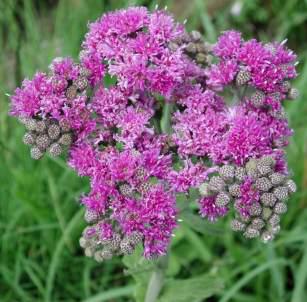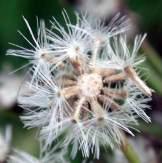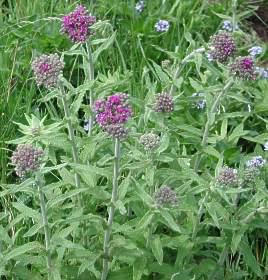Hilliardiella hirsuta
Hilliardiella hirsuta (DC.) H.Rob.
Family: Asteraceae
Common names: quilted-leaf vernonia (Eng.), wildesonsoekertjie (Afr.), ikhambi lenyongo (Zul.)
Introduction
The striking deep purple flowers and silvery quilted leaves of Hilliardiella hirsuta make it a very desirable plant for an indigenous summer border. This plant was previously known as Vernonia hirsuta.

Description
Description
Grows up to 1m tall in colonies in grasslands. The woody rootstock gives rise to hairy stems with thick stalkless leaves whose veins are deeply indented on the upper surface, giving a 'quilted' effect.

The flower heads, in common with all the members of the daisy family, are actually composed of many tiny florets grouped together. Appearing from September to January (spring to midsummer), they range in colour from magenta to purple, and occasionally pink or white. They are followed by attractive silvery seedheads.

Conservation Status
Status
Hilliardiella hirsuta is not threatened.
Distribution and habitat
Distribution description
A widespread species, occurring in Eastern Cape, KwaZulu-Natal, Free State, Lesotho, Eswatini, Limpopo (Northern Province), Mpumalanga, Zimbabwe and Angola. It grows in grassland, scrub, and on forest margins, in full sun to light shade, from the coast to 1900m. Frost hardy, it is found in the summer rainfall regions.
Derivation of name and historical aspects
History
Vernonia is a large genus of the daisy family, previously with about 1000 species found in the southern hemisphere, with 50 of these in South Africa. The genus was revised and some species removed to the new genus Hilliardiella. The genus Vernonia is named after William Vernon, an English botanist who collected plants in America and who died in 1711. The species name hirsuta refers to the hairy leaves.
The new name honours the botanist Dr Olive May Hilliard who studied Asteraceae in KwaZulu-Natal. There are 8 species in the genus Hilliardiella, including H. oligocephala with bi-coloured leaves and H. aristata with silvery foliage.
Ecology
Ecology
This plant does not seem to have a specialized pollinator. It is visited by bees, butterflies and beetles, which carry pollen from one flower to another. The seeds are enclosed in hairy fruits with a parachute of hairs which assists in wind distribution.

Uses
Use
This plant is used in traditional medicine to treat colic, sore throats, coughs, headaches and rashes. The Zulu common name means 'cure for the gall-bladder'. According to Pooley (1998), it is a hardy garden plant.

Growing Hilliardiella hirsuta
Grow
This species grows easily from both cuttings and seed. Once established, it needs to be cut back in late summer. The plant, which grows to about a metre, is best used in a mixed border, or in a naturalistic grassland garden. It contrasts particularly well with the bright yellow Berkheya species which flowers at the same time.
References
- Hilliard, O.M. 1977. Compositae in Natal, Univ. Natal Press, Pietermaritzburg.
- Pooley, E. 1998. A field guide to wildflowers of Kwazulu-Natal and the eastern region. Natal Flora Publ.Trust, Durban.
Credits
Isabel Johnson
Natal National Botanical Garden
January 2004
Plant Attributes:
Plant Type: Perennial, Shrub
SA Distribution: Eastern Cape, Free State, Gauteng, KwaZulu-Natal, Limpopo, Mpumalanga, North West
Soil type: Loam
Flowering season: Spring, Early Summer
PH:
Flower colour: Mauve/Lilac
Aspect: Full Sun
Gardening skill: Easy
Special Features:
Horticultural zones








Rate this article
Article well written and informative
Rate this plant
Is this an interesting plant?
Login to add your Comment
Back to topNot registered yet? Click here to register.